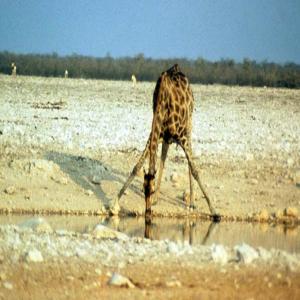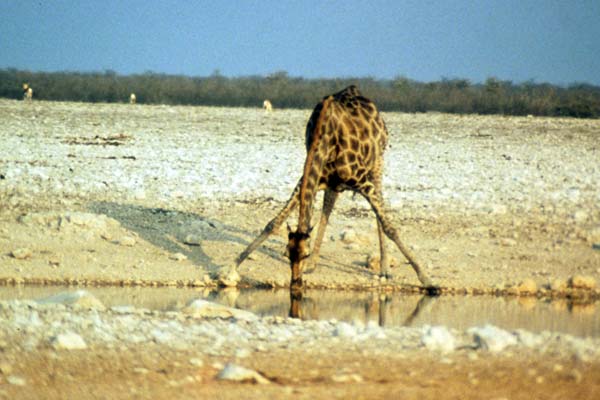Episodes

Monday Sep 13, 2010
The WildLife: Lorises, Anna Nekaris
Monday Sep 13, 2010
Monday Sep 13, 2010
Anna Nekaris, an expert on nocturnal primates, discusses Asia’s slow and slender lorises. She reveals to “The WildLife” host Laurel Neme what makes these creatures so special and why they’re sought after both as pets and as a key ingredient in traditional medicine. Did you know that the lovable, furry Ewoks in Star Wars films were modeled after slow lorises? But unlike Ewoks, lorises can’t jump or leap, which means they can only move through the forest canopy by using branches that touch.That makes an intact forest vital to their survival. Lorises are also one of the only venomous primates. They have a form of biological venom that’s produced by a gland in their elbows, which they mix with saliva to create a powerful toxin. These unique characteristics are what make them a sought after ingredient in traditional medicine across Asia. In fact, Anna and her research team recently completed the first major study of the use of lorises in traditional medicine in Asia and found a multitude of uses -- as a tonic for women after childbirth, for stomach problems, for healing wounds and broken bones, and in the treatment of sexually transmitted diseases. Lorises are seen as “an animal with 100 uses,” akin to aspirin in Western medicine. Anna Nekaris is a Reader and Course Tutor in Primate Conservation at Oxford Brookes University in the United Kingdom. She is also a member of the IUCN/SSC Primates Specialist Group, the Conservation Working Party of the Primate Society of Great Britain, and on the editorial board of Endangered Species Research and Folia Primatologica. Anna’s main research interests fall under the areas conservation, ecology, and speciation, with her fieldwork taking her to Trinidad, Senegal, Utah, India, Sri Lanka, Singapore, Indonesia, Uganda and Kenya. Although she has conducted fieldwork on bats, small carnivores (including civets and cats), mouse deer, and giant squirrels, her primary research focus is on primates. She has conducted many long-term studies of Indian and Sri Lankan slender lorises. Her current research project, on the diversity and conservation of Asian slow lorises, is being undertaken by Anna and postgraduate students in Java, Sumatra, Thailand, Cambodia, Laos, Singapore and Malaysia, where at least five species of slow loris are found. The team is using morphological, behavioral and vocal analyses to uncover diversity within this group. She has written several articles on the loris trade, including in Endangered Species Research and the American Journal of Primatology, contributed an article on the Javan slow loris to the IUCN/SSC Primate Specialist Groups Top 25 Most Endangered Primates, written a book that includes myths and legends on slender lorises, and contributes to the Loris Potto Conservation Database. This episode of “The WildLife” aired on The Radiator, WOMM-LP, 105.9 FM in Burlington, Vermont on September 13, 2010.

Monday Jul 26, 2010
The WildLife: Marine Aquarium Trade, Brian Tissot
Monday Jul 26, 2010
Monday Jul 26, 2010
Brian Tissot, marine ecologist, discusses the marine aquarium trade. He tells “The WildLife” host Laurel Neme how the United States, as the world's largest importer of marine ornamental species for the aquaria, curio, home decor and jewelry industries, has an opportunity to leverage its market power to promote more sustainable trade and reduce the effects of this trade on coral reefs worldwide. The trade in coral and coral reef species for ornamental purposes is substantial and growing, with approximately 30 million fish and 1.5 million live stony corals removed from the ecosystem each year. The aquarium industry alone targets some 1,500 species of reef fish, and many die in transit, prompting collectors to gather even more animals to compensate for potential losses. With the United States accounting for over half of the ornamental trade in live coral, reef fish and invertebrates, Tissot and 17 other scientists are calling on this country to leverage its market demand—through additional regulation and enforcement, public awareness campaigns, certification of sustainable products, and assistance to spread best practices in source countries—to make the trade more sustainable.
Dr. Brian Tissot is a Professor in the School of Earth and Environmental Science at Washington State University Vancouver. His research is focused on the interface between biology, management, and policy and examines ecological interactions between habitat and commercially important marine fishes and invertebrates and the role of the community in managing marine resources. Through collaboration with state, federal and international agencies he is involved in a range of activities including basic research, research with implications towards resource management, and environmental policy development in Hawaii, Washington, Oregon and California. In Hawaii, he helped improve the management of an aquarium fishery along the Kona coast by being a part of a collaborative research program with state biologists and policy makers, SeaGrant extension, and the local community. On the west coast he is examining the role of continental shelf invertebrates, especially deep water corals, and how they function as critical habitat for commercially important fishes. Information from his work has been used to improve management strategies for coral reefs in the Pacific, west coast bottom trawling, and in the development of legislation in Congress. In addition to over 60 publications in scientific journals, Dr. Tissot's work has been featured in Scientific American, National Geographic News, Smithsonian magazine and in the Washington Post. This episode of “The WildLife” aired on The Radiator, WOMM-LP, 105.9 FM in Burlington, Vermont on July 26, 2010.

Monday Jul 12, 2010
The WildLife: Philippine Forest Turtle, Pierre Fidenci
Monday Jul 12, 2010
Monday Jul 12, 2010
Pierre Fidenci, president of Endangered Species International (ESI), talks about his work to save “forgotten” endangered species. Speaking to “The WildLife” host Laurel Neme from the Philippines, he tells of his recent activities to save the rare Philippine Forest Turtle, one of the most endangered turtles on earth that is found on only two islands in the southern Philippines, and also to stop dynamite fishing in the country’s coral reefs. A common focus in ESI’s work is its emphasis on addressing the needs of the people that live within the habitat in order to achieve sustainable conservation of the endangered species you want to protect. Pierre Fidenci was born in Southern France, and at an early age was already involved in discovering, studying, and protecting nature. At the age of only 20, Pierre started Las Baulas National Marine Park in Costa Rica. At that young age, he also had already won multiple environmental awards including from Paul Sabatier University, the Nicolat Hulot Foundation, the French Government (Défit Jeune), and the Zellidja Foundation. More recently, he has received conservation awards from the Bp Conservation Programme, the Turtle Conservation Fund, and the Sophie Danforth Conservation Biology Fund. He has developed and directed conservation projects in South-, Central-, and North America, as well as in south East Asia, and Europe. His areas of expertise include amphibians and reptiles, applied conservation, biological surveys, and community based projects. Pierre is also a member of the IUCN Species Survival Commission (SSC). This episode of “The WildLife” aired on The Radiator, WOMM-LP, 105.9 FM in Burlington, Vermont on July 12, 2010.

Monday Jun 28, 2010
The WildLife: Reef Sounds, Corals and Reef Fishes, Steve Simpson
Monday Jun 28, 2010
Monday Jun 28, 2010
Steve Simpson, University of Bristol, about his research into ocean sounds and how reef fish and corals use these cues to find their way home. He tells “The WildLife” host Laurel Neme how research by him and his team of scientists has shown that corals, rather than drifting aimlessly after being released by their parent colonies and landing by chance back on reefs, instead find their way back purposefully by detecting reef noises like snapping shrimps and grunting fish. With coral reefs one of the most threatened ecosystems in the world, that discovery has staggering implications as it could means that coral larvae might struggle to find reefs because human noise, like drilling or boats, might mask their sound. Steve Simpson is a Senior Researcher at the University of Bristol's School of Biological Sciences. As a marine biologist and fish ecologist, he has particular interests in coral reef fishes, commercial fisheries, climate change, fish behavior and aquaculture. Specifically, he works on: the effects of climate change on European fish communities; underwater noise and its influence on fish behavior; fish population biology and dispersal; and population connectivity and marine protected areas. His work combines overseas fieldwork, often in remote and challenging developing country environments, with laboratory-based behavior experiments and computer modeling. His research has appeared in numerous research journals as well as the popular press, including the Los Angeles Times, the UK Guardian and The Independent, among others.This episode of “The WildLife” aired on The Radiator, WOMM-LP, 105.9 FM in Burlington, Vermont on June 28, 2010. Article and transcript available on Mongabay.com.

Monday May 03, 2010
The WildLife: Corals & Coral Reefs, Kristian Teleki
Monday May 03, 2010
Monday May 03, 2010
Kristian Teleki, SeaWeb’s Vice President for Science Initiatives and former Director of the International Coral Reef Action Network (ICRAN), reveals some of the mysteries of corals. He tells “The WildLife” host Laurel Neme about the biology and uses of corals and how much we still don’t know. He also discusses the threats to coral reefs and what can be done to halt their decline. Kristian Teleki joined SeaWeb as Vice President for Science Initiatives in November 2009. For the decade before that, he served as the Director of the International Coral Reef Action Network (ICRAN), a unique global partnership dedicated to addressing the serious decline in the health of the world's coral reefs. During his tenure there Kristian had oversight for more than 40 coral reef projects in 35 countries. Project activities ranged from livelihood diversification and resource management to the prevention and mitigation of ecological degradation of coral reefs through management, monitoring and public awareness actions. In addition to his ICRAN duties, Kristian established and led the One Ocean Programme at the United Nations Environment Programme's World Conservation Monitoring Centre, designed to reflect the interconnected nature of the world's seas and its coastlines, the rich and varied biodiversity they support, and human reliance on its resources and services. Kristian Teleki has a diverse background in marine science and conservation, and his field experience extends from the polar to tropical environments. He is particularly interested in the relationship that humans have with the ocean and promoting the sustainable use of its resources. He has degrees from the University of California, Santa Barbara, and Cambridge University. He also is on the Editorial Board of Aquatic Conservation, is a member of the Resource Users Group for the European Project on Ocean Acidification (EPOCA) and is a Steering Committee member of the Global Islands Partnership and the Global Forum on Oceans, Coasts, and Islands. This episode of “The WildLife” aired on The Radiator, WOMM-LP, 105.9 FM in Burlington, Vermont on May 3, 2010.

